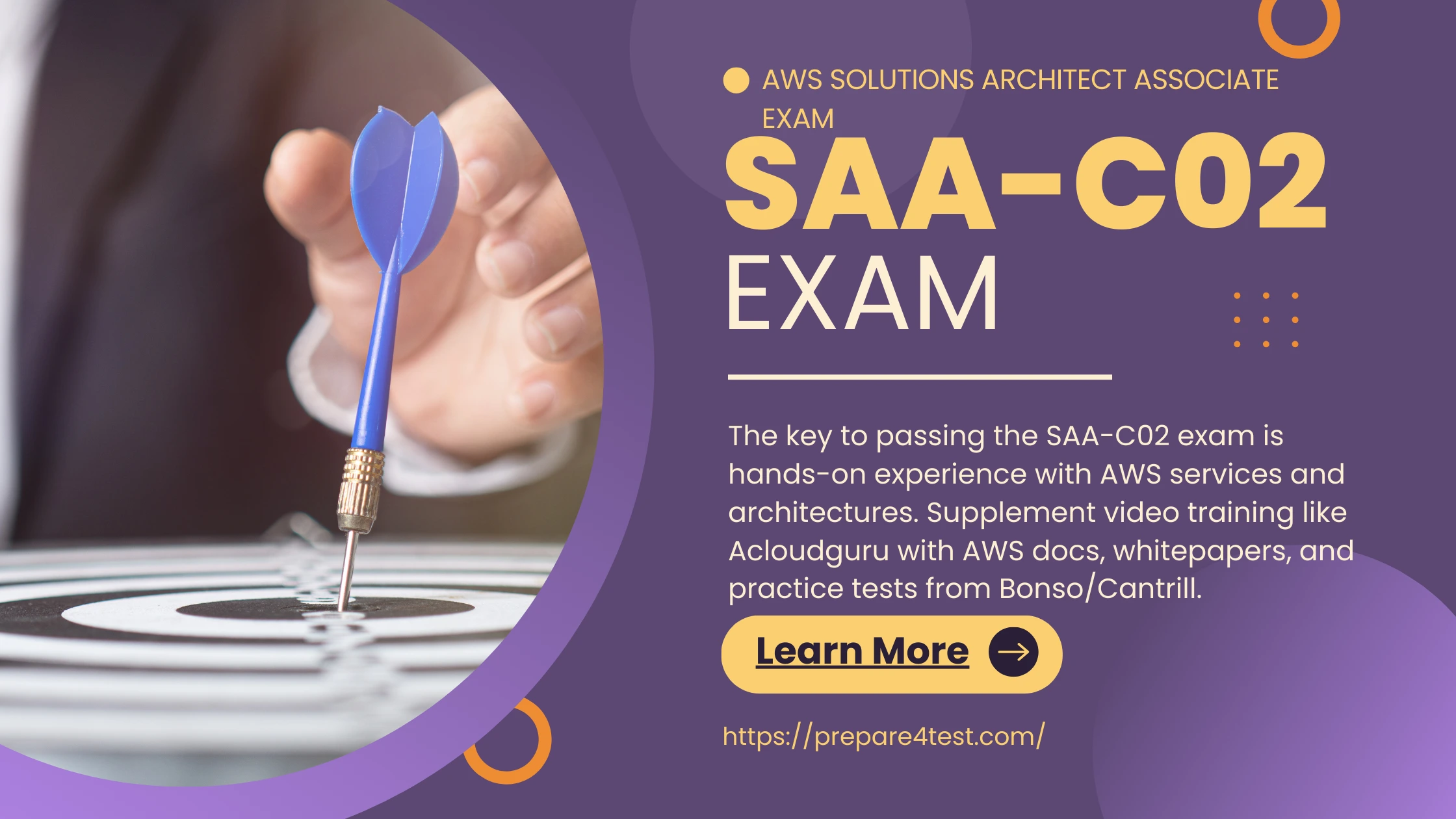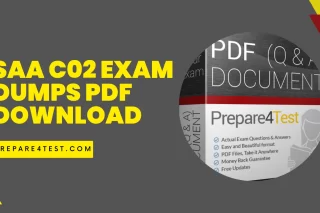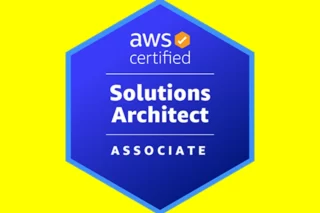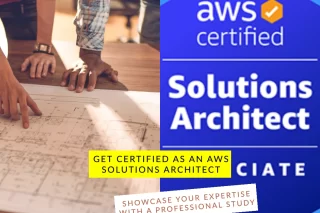
The Acloudguru SAA-C02 course is one of the most popular and comprehensive training options for passing the AWS Certified Solutions Architect – Associate exam. This course aligns directly with the SAA-C02 exam domains, covering key services like EC2, VPC, S3, and DynamoDB through hands-on demos and labs. Short 5-15 minute video lessons explain concepts clearly and concisely. The course is frequently updated to reflect changes to the AWS platform and new services added.
To supplement the Acloudguru course, many students use additional practice exams like Jon Bonso and Tutorials Dojo tests, which are known for their realistic questions. The Linux Academy SAA-C02 course is another good video training option. Whitepapers, documentation, and getting hands-on experience with AWS services are also important.
The key to passing the SAA-C02 exam is understanding the core concepts for each service and how they fit together in solutions, rather than just memorizing details. Take practice tests frequently to identify knowledge gaps. Focus your study on domains with lower scores. Get experience with AWS services through projects or hands-on labs. With diligent preparation using Acloudguru’s SAA-C02 course and supplemental materials, you can feel confident walking into the exam.
Overview of the SAA-C02 Exam
The AWS Certified Solutions Architect – Associate certification validates technical expertise in designing and deploying cloud-based solutions on the AWS platform. It is one of the most popular and in-demand cloud certifications today.
Pursuing this certification demonstrates hands-on experience with AWS services and following best practices for building secure, robust, and cost-optimized systems in the cloud. The certification exam covers important topics like compute, storage, networking, security, resilience, and cost optimization.
Earning the AWS Certified Solutions Architect – Associate certification can benefit your career in several ways. It boosts your credibility and demonstrates your cloud architecture skills to employers. Certified architects on average earn a higher salary compared to those without certification. The certification also expands your career opportunities, as more companies adopt AWS and need certified talent.
Overall, the AWS Certified Solutions Architect – Associate certification validates your ability to design cloud-based solutions and is a valuable credential for anyone working in a solutions architect or similar technical role using AWS. It shows you have the necessary knowledge and skills to be successful in implementing projects on AWS.
Exam details:
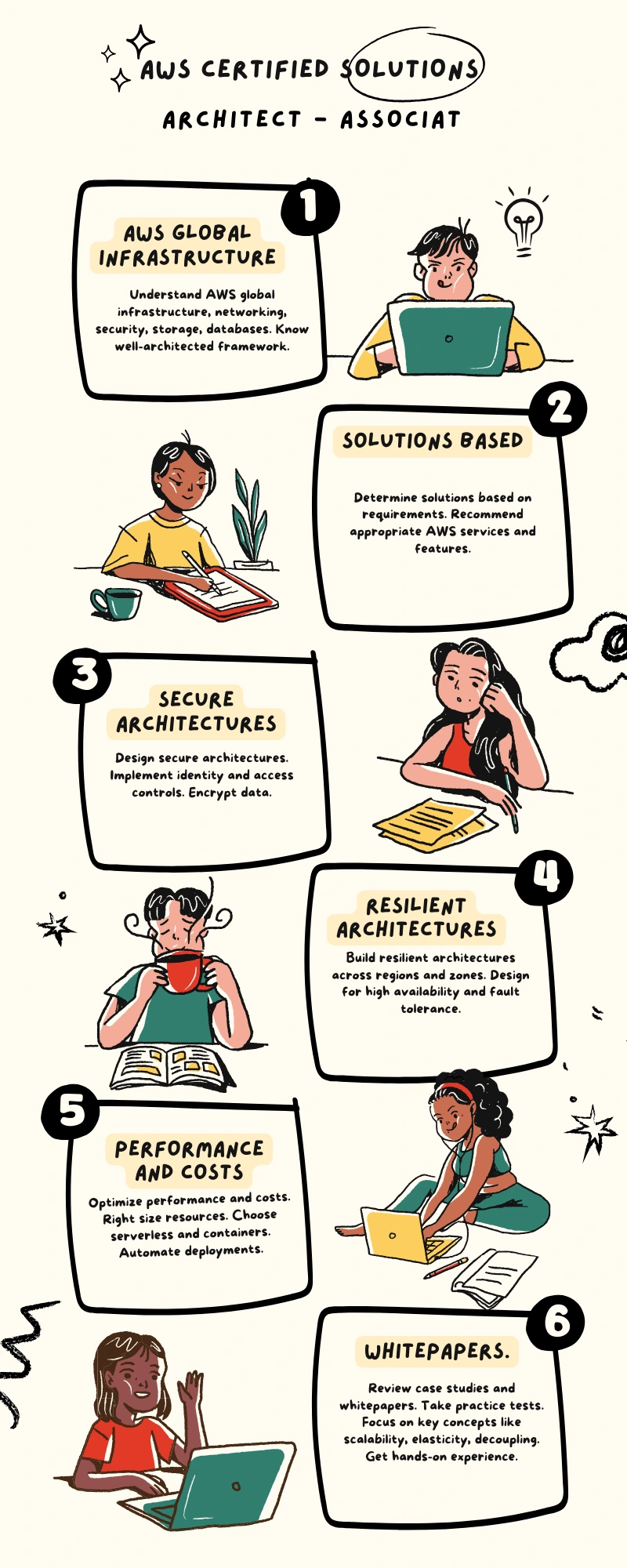
The AWS Certified Solutions Architect – Associate exam consists of 65 multiple choice and multiple response questions that you must complete within 130 minutes.
There are two types of multiple choice questions on the exam:
– Single select – Choose one correct response out of four options
– Multiple select – Choose two or more correct responses out of five or more options
You should read each question carefully and select the response(s) that best answers the question. Watch out for responses that seem correct but do not fully address the question.
The exam covers four key domains, each with a percentage weighting:
– 1 Domain: Design Resilient Architectures (30% of exam)
– 2 Domain: Define Performant Architectures (24% of exam)
– 3 Domain: Specify Secure Applications and Architectures (24% of exam)
– 4 Domain: Design Cost-Optimized Architectures (22% of exam)
The passing score for the exam is 720 out of 1,000 points. AWS does not publish the raw cut score needed to pass.
Gaining familiarity with the exam format and question types through practice tests is key to success. Focus your study on understanding the core concepts versus trying to memorize trivia. With diligent preparation, you can pass the AWS Certified Solutions Architect – Associate exam.
Design Resilient Architectures (30%)
Designing resilient architectures involves building systems that can withstand failures and recover quickly. This domain tests your ability to design highly available, fault-tolerant systems on AWS.
Key areas covered include:
– Implementing multi-tier architectures with high availability
– Using decoupling mechanisms like SQS between components
– Leveraging autoscaling to dynamically add/remove resources
– Distributing instances across Availability Zones
– Caching with services like ElastiCache for performance
– Designing storage with redundancy, backups, and point-in-time recovery
– Using Route 53 DNS with health checks for automatic failover
– Monitoring with CloudWatch alarms and SNS notifications
To pass this domain, you need real-world experience with AWS services and understanding best practices for availability and disaster recovery. Focus your study on core well-architected principles like redundancy, automation, loose coupling, and creating balanced architectures. The more hands-on experience you have building resilient systems on AWS, the better prepared you’ll be for this critical exam domain.
Design High-Performing Architectures (28%)
Designing high-performing architectures involves building systems that can handle heavy workloads and scale to meet demand spikes. This domain tests your knowledge of compute, storage, network, and database services for performance.
Key areas covered include:
– Choosing high throughput storage like Amazon S3 and EBS
– Using autoscaling groups and load balancing for elastic compute
– Distributing instances across Availability Zones for proximity
– Leveraging caching services like ElastiCache and CloudFront
– Using Amazon RDS for relational databases and DynamoDB for NoSQL
– Designing decoupled event-driven architectures with SQS and SNS
– Optimizing network throughput with Direct Connect and VPC endpoints
To pass this domain, hands-on experience building performant systems on AWS is crucial. Focus your study on compute options, distributed architectures, caching strategies, and database selection. Understand how to monitor, tune, and optimize system performance. The more real-world experience you have operating large-scale distributed applications on AWS, the better prepared you’ll be for this performance-focused exam section.
Design Secure Applications and Architectures (24%)
Designing secure applications and architectures involves implementing controls and features to protect data, apps, and infrastructure. This domain tests your ability to build secure access, data protection, infrastructure security, and compliance on AWS.
Key areas covered include:
– Managing access with IAM users, groups, roles, and policies
– Securing VPC environments with security groups, NACLs, and encryption
– Protecting data at rest and in transit with KMS and SSL/TLS
– Leveraging AWS WAF, Shield, Macie, and GuardDuty for threat protection
– Implementing logging, monitoring, and auditing with CloudTrail and CloudWatch
– Aligning security controls to meet compliance objectives like HIPAA and PCI
To pass this domain, hands-on experience with AWS security services is crucial. Focus your study on IAM, VPC security, data encryption, security monitoring, and compliance requirements. Understanding how to apply the shared responsibility model and integrate security across multiple services is key. The more real-world experience you have building secure architectures on AWS, the better prepared you’ll be.
Design Cost-Optimized Architectures (18%)
Designing cost-optimized architectures involves building systems that maximize performance and availability while minimizing cost. This domain tests your ability to select the most cost-effective options for compute, storage, network, and databases on AWS.
Key areas covered include:
– Comparing compute instance types and families based on cost
– Using auto-scaling and load balancing to optimize resource usage
– Selecting storage tiers like S3 Standard vs S3 Infrequent Access
– Using provisioned services like RDS over self-managed databases
– Leveraging cost-effective network options like VPC peering
– Analyzing usage data with Cost Explorer to find savings
– Creating budgets and alarms to monitor spending
– Utilizing Savings Plans and Reserved Instances for discounts
To pass this domain, real-world experience using the AWS pricing calculator and TCO tools is important. Focus your study on compute, storage, and database pricing models and how to optimize them. Understand how different service options impact cost. The more hands-on experience you have operating real workloads on AWS while staying within budget, the better prepared you’ll be.
Recommended Training Course: Acloudguru SAA-C02
Course modules align to the SAA-C02 exam domains
The Acloudguru SAA-C02 course is structured into modules that map directly to the four exam domains tested on the AWS Certified Solutions Architect – Associate exam. This helps ensure you are covering all the key knowledge areas required to pass.
The modules cover:
– 1 Module: Design Resilient Architectures
– 2 Module: Define Performant Architectures
– 3 Module: Specify Secure Applications and Architectures
– 4 Module: Design Cost-Optimized Architectures
Within each module, short video lessons explain the concepts, services, and best practices related to that domain. Quizzes reinforce knowledge, while hands-on labs provide practical experience.
By aligning the course modules to the SAA-C02 exam domains, Acloudguru ensures you are learning the material that will be tested. This structured approach makes it easier to prepare and identify any knowledge gaps prior to taking the actual certification exam.
Covers key services like EC2, VPC, S3, DynamoDB, RDS, ECS, etc.
The Acloudguru SAA-C02 course provides in-depth coverage of the most important AWS services that are frequently tested on the Solutions Architect Associate exam. Through video lessons and hands-on labs, you will gain practical experience using core AWS compute, storage, database, and networking services.
Key services covered include:
– EC2 for provisioning virtual machines
– VPC for isolating resources in a virtual network
– S3 for object storage
– DynamoDB for NoSQL databases
– RDS for relational databases
– ECS for running containerized applications
The course also covers many other essential AWS services like Lambda, API Gateway, SQS, SNS, ELB, Auto Scaling, Route 53, CloudFront, and more.
By learning how to architect solutions using these key AWS building blocks, you will be well-prepared to pass the SAA-C02 exam and demonstrate your ability to design systems on AWS. The hands-on experience with core services makes the Acloudguru course invaluable.
Includes demo videos and hands-on labs for experience with AWS console
One of the best ways to prepare for the AWS Certified Solutions Architect Associate exam is to get hands-on experience using the AWS console and services. The Acloudguru SAA-C02 course provides this practical experience through interactive demo videos and labs.
The video lessons often include short demo clips that show the instructor navigating the AWS console and configuring services step-by-step. Being able to follow along helps reinforce key concepts and gets you comfortable working in the AWS environment.
The course also includes full lab exercises where you get to practice skills like provisioning EC2 instances, configuring VPCs, storing objects in S3, and more. The labs provide a safe sandbox to experiment with AWS services at your own pace. They help cement your knowledge by putting lecture concepts into action.
Getting hands-on experience with AWS is crucial for passing the SAA exam and succeeding as a solutions architect. The Acloudguru SAA-C02 demo videos and labs ensure you will have the practical experience needed to leverage AWS services for real solutions. The labs also prepare you for the hands-on question types seen on the exam.
Practice exams help reinforce knowledge and identify gaps

The Acloudguru SAA-C02 course includes practice exams designed to test your knowledge and prepare you for the real AWS Certified Solutions Architect Associate exam. These timed practice tests simulate the actual exam experience and question format.
The practice exams expose any weak areas you still need to study and solidify concepts you already understand. Reviewing the detailed explanations for both correct and incorrect answers helps reinforce your knowledge. Taking the practice tests frequently throughout your exam preparation identifies gaps early on, when you still have time to review.
The Acloudguru practice exams also help you become familiar with how AWS words questions and the level of detail required. They cover all the exam domains, allowing you to experience the different types of questions per section.
Scoring yourself truthfully on the practice tests gives you a realistic idea of your exam readiness. Focus your final preparation on domains or services that need improvement to ensure you pass on your first try. The Acloudguru SAA-C02 practice exams are crucial for confirming your exam readiness.
Supplemental SAA-C02 Study Resources
In addition to the Acloudguru SAA-C02 course, there are many other helpful resources to supplement your exam preparation.
Key supplemental materials include:
– AWS whitepapers and documentation – Provide technical details on services
– Jon Bonso/Tutorials Dojo practice exams – Realistic questions to identify knowledge gaps
– Linux Academy SAA-C02 video course – Alternative video training option
– Neal Davis/ExamPro SAA-C02 video course – Video lessons from exam expert
– Adrian Cantrill’s SAA-C02 video course – Comprehensive and highly recommended
– ExamPro practice exams – Additional practice tests for exam readiness
– AWS sample case studies – Real-world examples and solutions on AWS
A well-rounded preparation plan should include hands-on experience, video training, practice questions, case studies, and referencing AWS documentation/whitepapers. The Acloudguru course provides the foundation, while supplemental materials fill in any gaps.
Study Tips and Strategies
Take Notes and Review Regularly
– Take detailed notes on AWS services and concepts as you go through training materials.
– Reviewing notes regularly reinforces knowledge and helps recall information faster.
Use AWS Documentation as the Source of Truth
– Treat AWS user guides, whitepapers, and FAQs as the ultimate authority on services.
– Confirm your knowledge is accurate by referencing AWS docs when taking practice tests.
Do Practice Tests in Review Mode
– Take practice exams in review mode to treat questions like flashcards.
– Reviewing answers immediately helps identify weak areas to study.
Get Hands-on Experience
– Nothing beats hands-on experience for learning concepts thoroughly.
– Build projects and work through labs to gain practical skills.
Take Practice Exams Under Real Conditions
– Take full-length practice tests under timed, simulated exam conditions.
– Identify knowledge gaps while you still have time to review and improve.
Focus on Understanding Concepts
– Aim for understanding versus trying to memorize trivia.
– Learning core concepts prepares you to apply knowledge flexibly.
Tracking Study Progress
Take Baseline Practice Exam
– Take an initial full-length practice exam in timed mode to identify knowledge gaps.
– Use the results to determine which domains need the most review.
Review Explanations Thoroughly
– For any missed practice exam questions, read the explanations carefully.
– Understand why the correct answer is right and why yours was wrong.
Track Practice Exam Scores
– Take practice exams regularly under timed conditions as you study.
– Chart your scores to monitor improvement over time.
Revisit Weak Domains
– Focus additional study on domains where you scored the lowest.
– Be sure to re-take practice exams to confirm improvement.
Take Final Practice Exam
– Take a full timed practice exam 1 week before your real exam date.
– Use the results to guide your final preparation week.
Review Key Concepts
– In final week, review notes/flashcards and brush up on key services.
– Reread difficult practice exam explanations.
Conclusion
The key to passing the SAA-C02 exam is hands-on experience with AWS services and architectures. Supplement video training like Acloudguru with AWS docs, whitepapers, and practice tests from Bonso/Cantrill. Take detailed notes and review regularly to reinforce concepts. Identify knowledge gaps early using practice exams in timed mode. Focus on understanding core concepts and how services work together. With diligent preparation using quality resources, you can gain the knowledge needed to pass the SAA-C02 exam on your first attempt.
